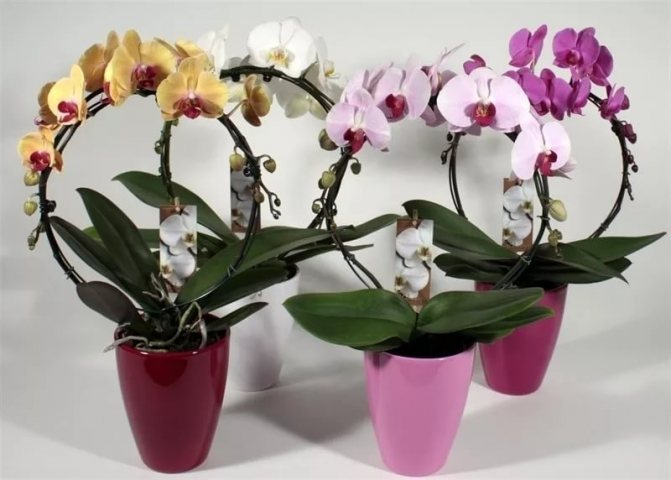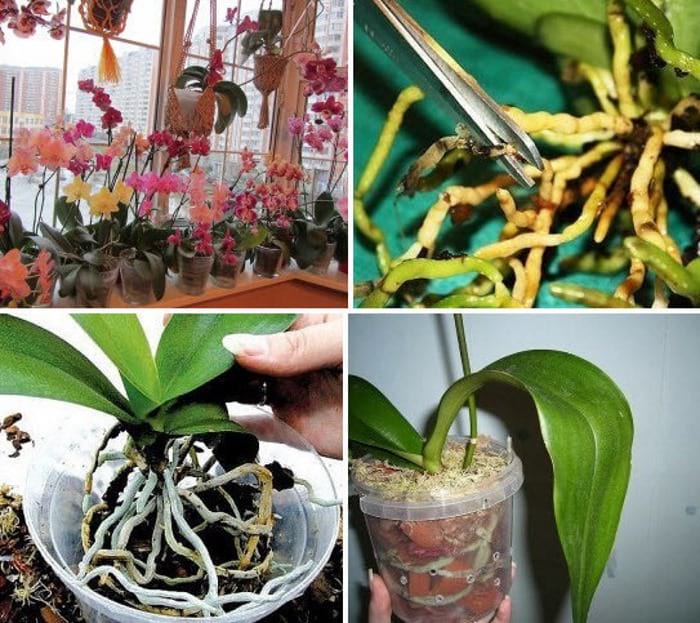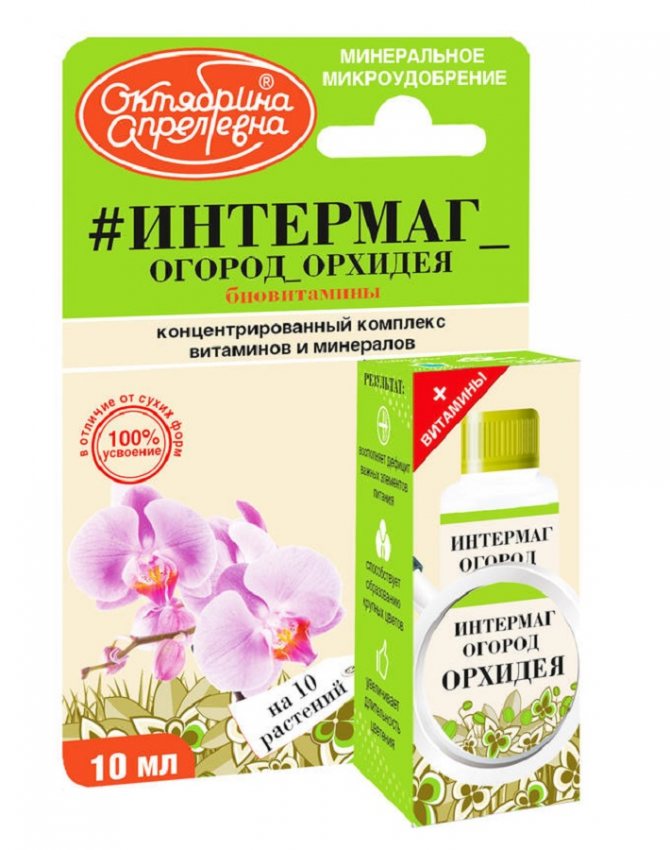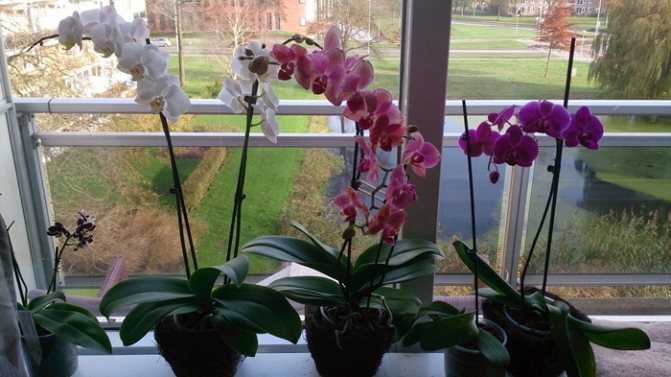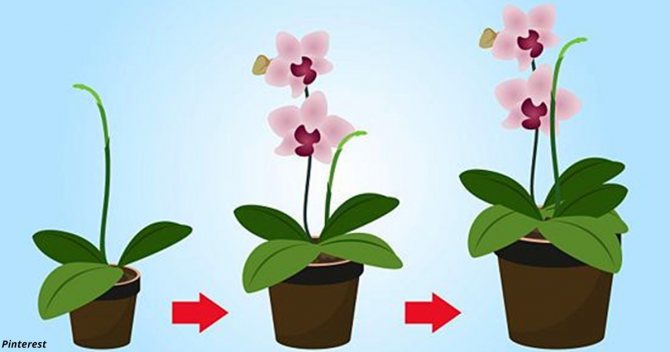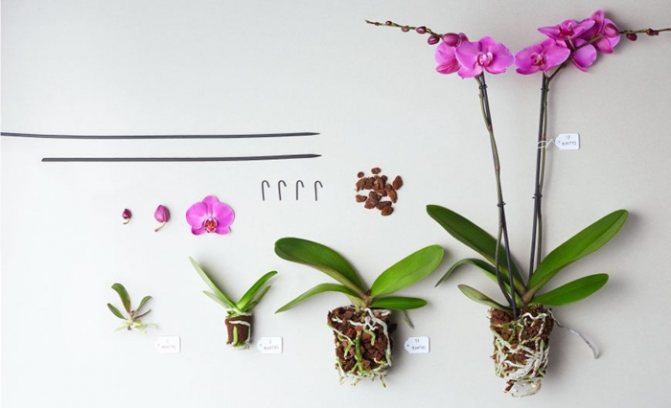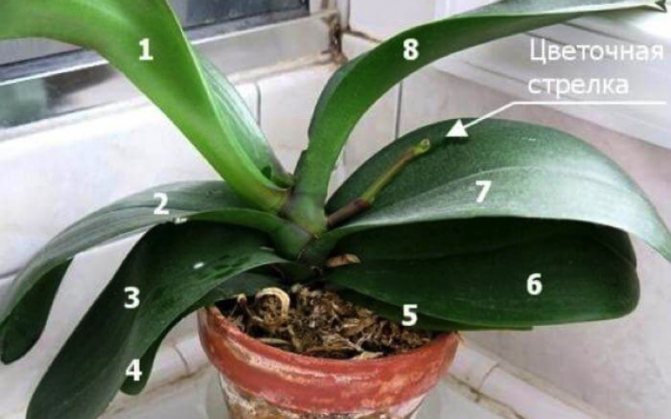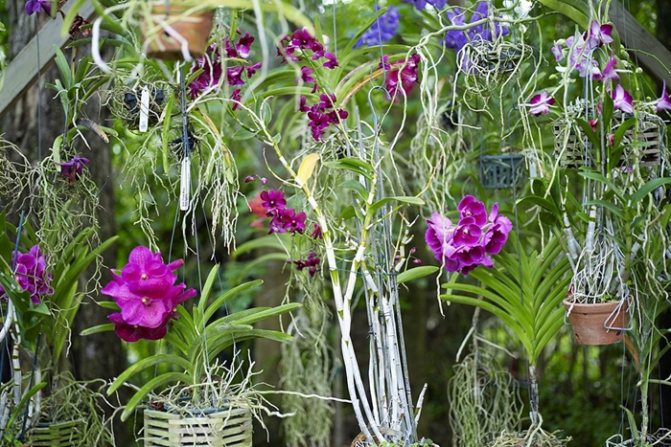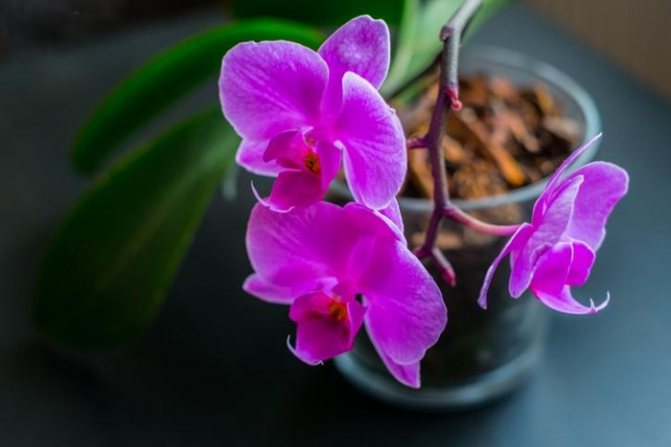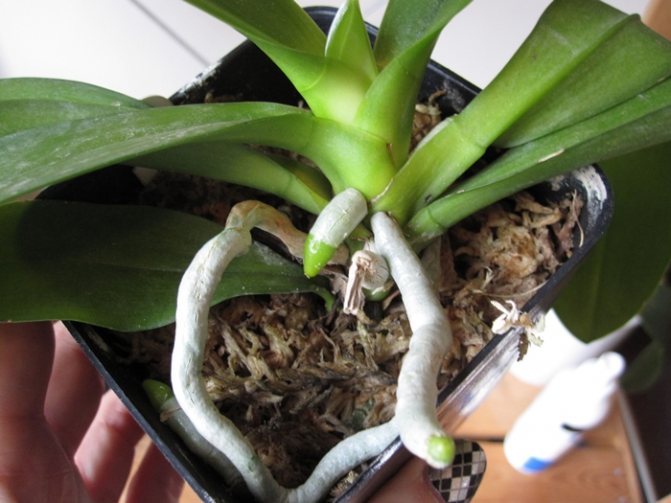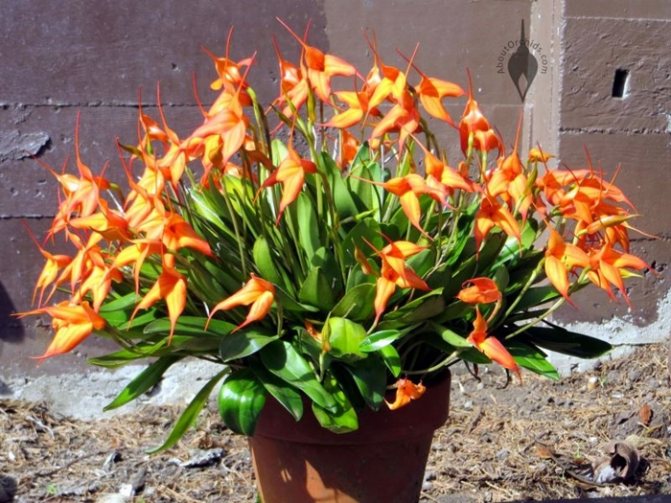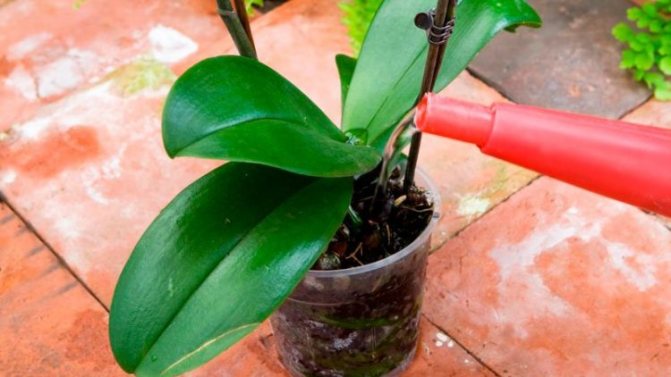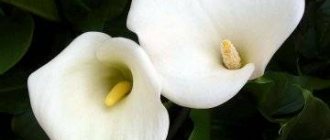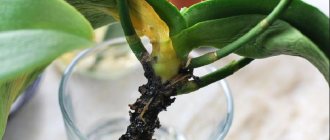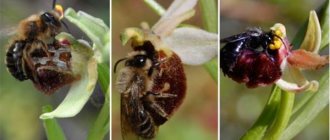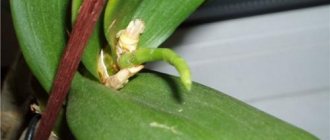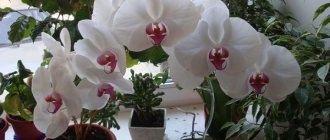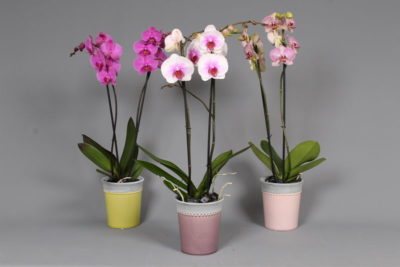
Phalaenopsis is an incredibly beautiful flower that adorns the windowsills of thousands of Russian apartments. So you want indoor plants to please the owners with their flowers for as long as possible.
If an orchid does not bloom for a long time at home, this is a reason to be wary. It is necessary to determine the reason for this and do everything so that the phalaenopsis again spoils the owners with its flowering.
When to expect flowering?
On average, an orchid blooms for about 3 months.... Some especially talented orchid growers manage to extend this period to 5, or even 8 months. Then the plant enters a dormant period, gaining strength for a new flowering. The cycle of flowering and resting is different for each plant, therefore there is no exact data on when exactly the plant should release a peduncle and decorate the window.
Taking proper care of the plant can shorten the rest period as much as possible. Phalaenopsis is able to bloom almost all year round if it receives enough water, nutrients and light, as well as if the correct temperature regime is observed. If we are talking about the first flowering of a young plant, then you do not need to wait for it earlier than 2 years after planting.
Correct soil and top dressing
Grooming means feeding, because orchids are nourished only from water and air. The substrate consists of large fractions of tree bark, sphagnum moss, coconut fibers, vermiculite, pebbles. It is used to fix the roots, retain moisture after watering. How do you make it right? It is better to buy a ready-made mixture in the store, as well as fertilizers. During the growing season, the plants are fed 2-3 weeks later with solutions of special fertilizers. More nitrogen is needed for growth, and phosphorus and potassium for flowering.
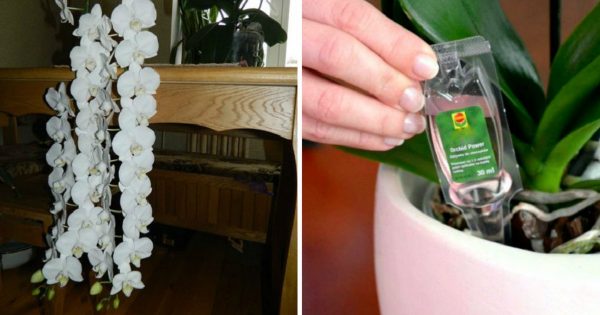

Reasons for the absence of buds
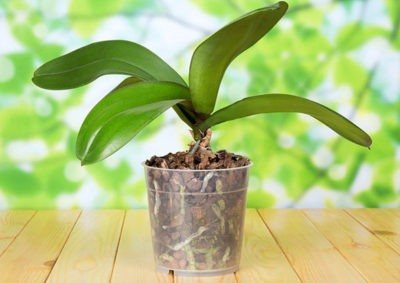

What if the orchid doesn't bloom? In a house or apartment, it is difficult to recreate the conditions of the natural habitat of the phalaenopsis. but regular care according to all the rules stimulates a rich and long-lasting flowering of the orchid.
- excessive or insufficient watering;
- the flower was acquired at the end of the flowering period;
- high room temperature;
- excess salts in the soil;
- lack of light;
- excess or lack of feeding;
- incorrectly selected fertilizers.
Orchid growing conditions
For? in order for a houseplant to bloom, it needs to provide the correct growing conditions, which include:
- Compliance with temperature conditions
- Moderate watering
- Optimal temperature creation
- Regular fertilization
A rather important aspect in growing an orchid is the temperature regime. An indoor plant will only bloom at an optimal temperature. Some varieties are capable of fully tolerating temperatures up to +50 degrees, but some species begin to dry out if the room temperature is more than +25 degrees. That is why it is necessary to study the conditions before growing an orchid. Also, the florist must carefully monitor the temperature drops that the orchid does not tolerate.
In winter, it is recommended to create optimal conditions that require artificial lighting. For this purpose, the use of conventional incandescent lamps is prohibited. This is due to the fact that when they are used, the flower is heated.That is why it is best to use halogen, fluorescent, mercury or sodium lamps, the power of which is no more than 40 watts. The duration of the light regime must be at least 14 hours.
It is strictly forbidden to place the plant pot above the radiators!
Watering the plant should be carried out in compliance with the temperature regime of the water. Otherwise, the flower can get stressed and refuse to bloom. For irrigation, it is recommended to choose water that fully matches the room temperature. Some thermophilic species require hot watering. At the same time, flower growers must ensure that its temperature does not exceed +45 degrees. It is strictly forbidden to use cold water for irrigation, regardless of its type. When watering, the grower must ensure that the water completely drains from the roots.
Ensuring optimal conditions during the growing period of an orchid is the key to its success.
Problems and their elimination
Proper attention from the owner of the orchid and care at home will stimulate flowering. If the plant does not bloom, there are several reasons.
Diseases
The most common diseases:
- bacterial spot - brown spots appear on the leaves;
- sooty mushrooms contribute to the formation of black plaque on the leaves;
- powdery mildew - a disease that manifests itself in the appearance of a white bloom;
- rotting plantswhen the root system and leaves rot.
What do we have to do:
- Remove all affected areas of the plant.
- Apply a special drug designed to treat a specific type of disease.
- If the plant begins to rot, you need to cut off all the damaged areas, change the substrate and pot, and transplant the orchid.
Pests
The most common pests of orchids: thrips, scale insects, mealybugs, whiteflies, aphids, mites... Pests live both in the leaves and in the substrate. The pest affects not only the frequency and duration of flowering, but also the general condition of the plant.
How to identify the presence of a pest:


the pot of the newly purchased plant must be lowered into the water so that the edge of the pot is above the water level: the pests will crawl out of the substrate;- Leaves, roots, and buds should be carefully inspected for silvery paths, bumps, brown spots, sticky areas, cobwebs, and small depressions.
To destroy pests it is necessary:
- rinse the plant thoroughly with water and laundry soap;
- treat the substrate, plant and roots with a solution of a broad-spectrum insecticide, repeat after a week.
How to properly care for?
Phalaenopsis is an unpretentious orchid, but it is sensitive to habitat and care conditions:
- If the plant stands in a too dark place, or in a place with an abundance of direct sunlight, you should not wait for flowering. The orchid should be in a location with sufficient, but not too bright, lighting. If you cannot move the pot from a place with abundant sunlight, it is enough to darken the window a little with special paper or foil.
- It is necessary to properly water the plant - no more than 1 time in 4 days and only in the morning.
- The room should not be too hot and humid - such conditions provoke rotting.
- Do not repot the plant or move the pot unless absolutely necessary.
- Frequent fertilization is not good for this plant. You need to make top dressing only in the spring-summer period 1 time in 2 weeks.
Basic prerequisites for abundant flowering
Orchid bloom lasts 3 months, and some specimens, depending on the species, can please up to 8 months. For the abundant flowering of the orchid influenced by the following factors:
- As soon as all the buds open, the flower is rearranged in partial shade. In this case, the sun's rays will be unnecessary;
- Adhere to a cool temperature from 17 degrees C to 22;


Several factors affect the abundant flowering of an orchid.
How to wake up from sleep?
Phalaenopsis is not the most capricious plant, so it is not so difficult to wake up an orchid.as it seems at first glance. There are two main ways to make an orchid wake up from sleep: by using artificial drought or by using a temperature difference. Both methods give the plant a “shake-up” and encourage active flowering. The choice of the method is at the discretion of the owner.
For details on what to do next with the phalaenopsis orchid after flowering, read here.
Artificial drought
This method will help at any time of the year and at any stable room temperature (no higher than 30 ° C) to force the orchid to start blooming. The flower awakening process will take from 1 to 2 months..


It is necessary to dramatically increase the time intervals between waterings. You need to wait until the soil and roots are completely dry after the last watering, then refrain from watering for 4-7 days, depending on the room temperature, and only then water. There is an easier way - to increase the watering intervals by 2 times.- Plants cannot be sprayed in long intervals between waterings, this tactic will nullify all efforts. It is also necessary to abandon fertilization. There is no need to feel sorry for the orchid, otherwise there will be no result.
- When the peduncle is formed, you can return to the previous watering regime.
- If the flowering period after stimulation fell on autumn and winter, when the daylight hours are very short, you need to get a fluorescent lamp. As soon as a peduncle appears, the plant must be supplemented, otherwise further development may stop.
Temperature difference
This method of stimulation is suitable for most orchids.... Let's consider its features:
- In spring, when the night temperature reaches around 16 ° C, the plant should be taken out onto the balcony close to the open window.
- If it is possible to protect the orchid from direct sunlight, you can keep it on the balcony all day, but if this is not possible, take it out only at night.
- Phalaenopsis will be warm during the day and cool at night. As a result of such changes, the plant gains strength for the development of the peduncle, the growth of leaves and roots. Usually 10-15 days are enough for stimulation.
The temperature drop method can also be used in summer and autumn, but it is in the spring that the greatest results can be achieved. If the plant is not properly cared for, flowering stimulation will not give good long-term results.
Do I need to artificially stimulate the plant?
For in order for a newly transplanted orchid to give large and bright flowers, you should take care of artificial stimulation of its flowering... It is important to make sure that the plant is completely healthy, has strong roots and strong and fleshy leaves.
- Most often, the flowering of an orchid is stimulated by placing it in a stressful situation. If the plant has begun to "lazy" and has not produced a peduncle for a long time, you can try to push it to bloom by watering. To do this, immerse the pot in water heated to 40-45 ° C and leave it there for 30 minutes.
- A hot shower is also a useful stimulant for orchid bloom. Place the plant in a bathtub and spill its leaves and roots with a very warm stream of water (the temperature must be tolerable on the hands, otherwise you can burn the roots and leaves!).
- If the orchid has never bloomed, despite the appropriate age, as well as the quantity and quality of the shoots, you can try sending it to a cool balcony for a week or two (the room temperature should not drop below 0 ° C). This procedure simulates the wintering of a plant in natural conditions, thereby bringing its flowering period closer. After you bring the flower back into the house, a peduncle will soon appear on it.
Home care
Proper care during the flowering period determines its duration.... The basics of proper care:
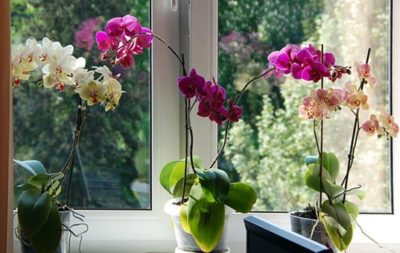

provide a temperature difference: from 20-23 ° С during the day, up to 15-17 ° С at night;- determine a place for the pot and not move it - the plant does not like rearrangements and changes in the direction of light;
- use special photo lamps in the autumn-winter period, the lighting should be directed to the top of the peduncle;
- the orchid pot should be made of transparent, smooth plastic, since the roots of the plant also need sunlight;
- for abundant long flowering, phalaenopsis must be fertilized with specialized formulations containing phosphorus and potassium;
- it is good if the window on which the orchid was placed has a south or east direction - this way the plant will receive more light;
- it is necessary to observe the watering regime: too frequent watering harms the plant and deprives it of the opportunity to bloom often and for a long time.
Why doesn't it start for a long time?
There may be several reasons why the orchid is in no hurry to please its owner with flowers for more than a year, or even two.
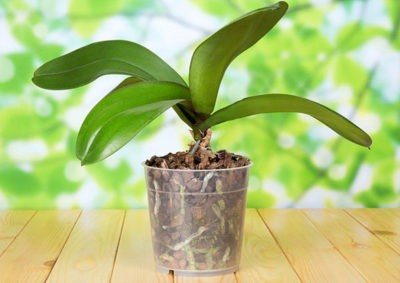

Any species of orchid plants really do not like movement in space. Even the pot turned the other side to the light source becomes a serious stress for them. As a result of the rotation and rearrangement of the plant from place to place, delays in the appearance of the peduncle may occur, as well as the falling off of already set buds may begin.- A common reason an orchid does not bloom may be due to insufficient illumination of its root system. It is the roots that provide full-fledged photosynthesis of the entire plant, therefore, flowering orchids should only be planted in transparent pots.
- An orchid will never bloom if there is not enough light for it. Therefore, for the flowering of this plant, it is important to provide it with the proper level of illumination. On winter days, LED lamps will come to the rescue, which will help to extend the daylight hours for the required amount of time (as a rule, orchids require 10 hours of bright light for regular flowering).
- The lack of daily and seasonal temperature changes in the room also leads to a delay in orchid flowering. In this case, all that is needed for flowering is to create the plant as close to natural conditions as possible, making sure that the air temperature at night is 4-6 ° C lower than during the day. An excellent solution would be to create artificial wintering for a green pet for at least 20 days at a temperature of 5-10 ° C above zero.
Bloom
Age of onset
When caring for an orchid there are many tricks and subtleties, capable of ensuring the flowering of a beauty for a period of 2 to 6 months and longer. And such varieties as, for example, Phalaenopsis, can delight with their flowers all year round.
Often, how long an orchid blooms depends on the age of the plant... Many novice flower growers mistakenly believe that it is just a young plant that blooms vigorously, but this is not at all the case. The flowering period can begin only after 1.5-3 years.
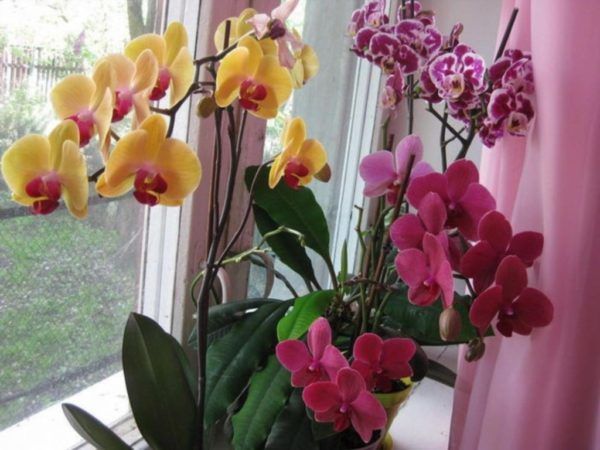

Only an adult plant is capable of blooming.
That is, the older the orchid, the more chances that the lush inflorescences will delight the owner all year round. And the question of how to make it bloom all year round will not even be raised.
The necessary conditions
The flowering frequency of orchids depends on a number of factors that must be observed collectively and never individually. Consider what is needed for flowering.
Location
Any orchid variety does not tolerate stress, especially when it comes to moving the pot.
If circumstances still force you to move the plant to another place, experienced florists recommend marking the side of the orchid that was located towards the sun.
This can be done with the help of a mark on the pot and put the flower towards the sun exactly on the side it stood on.
It is also recommended to water the plant without changing the location of the flower. Even the slightest movement during the growth of the peduncle is destructive.
Age
On average, an orchid is ready to bloom at the age of 1.5 to 3 years. Everything depends on the conditions in which the flower grows and develops. You can determine the age by the leaves: a plant suitable for flowering has at least 5 mature leaves.
The younger the plant, the more likely it is that early flowering will lead to death, because the flower simply will not cope with the load.
Root system
It is this part of the plant that actively participates in photosynthesis, therefore the presence of natural light is strictly required!
Lighting
Absolutely all orchid varieties are sunshine lovers. And the presence of this light is a fundamental factor in the growth of the peduncle. Plants have the hardest time in winter, when the length of daylight hours is too short. In such cases regular lamps should be used to make up for the lack of light.
If the growth of the peduncle fell on the grayest and gloomiest period, then for healthy growth and development, it is recommended to highlight the tip of the peduncle, and not the entire plant. Lack of sufficient lighting leads to inevitable death, especially during the flowering period.
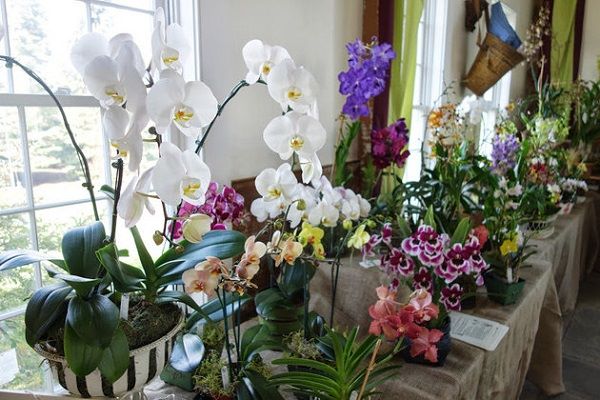

Lighting is one of the most important factors for flowering.
Content temperature
The main secret of successful flowering is to reduce the night temperature. The drop can vary from 4 to 15 degrees.
In the summer, for example, the orchid can be taken out into the fresh air, this will provide a natural temperature drop. In autumn and spring, it is recommended to simply ventilate the room, but beware of too low temperatures. Draft is detrimental to orchids.
Top dressing
In order for the orchid to bloom with enviable regularity, it is worth paying great attention to the correct fertilizers.
Humidity
To provide the orchid with sufficient moisture, experienced flower growers recommend placing a container of water next to the plant... When using this method, you can be sure that the plant will receive as much moisture as required.
Proper watering
To determine whether a plant needs watering, you can use one simple rule: pay attention to the root processes: if they are pale, this means that the plant needs moisture.
However, do not forget that excess moisture will lead to rotting of the root system and possible death of the plant.
To grow a healthy, beautiful orchid, you must clearly understand all its needs.
What to do to make the orchid bloom again?
No matter how strange it may sound in relation to the orchid, but, getting used to comfortable conditions, the plant may stop blooming... However, don't panic, there are some tricks that can perfectly stimulate orchid growth. Ways to make it bloom again include:
- temporary reduction in the dosage of water;
- moving the plant to a cool place.
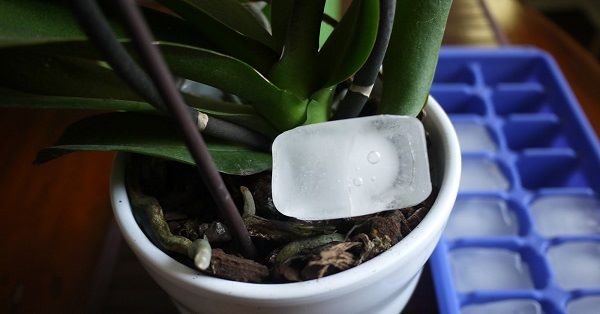

A temporary drop in temperature can stimulate flowering.
Stress is ideal for stimulating flowering
The method of creating a stressful situation to stimulate the flowering of a plant is used by many people, due to its high efficiency. Best of all, the procedure will be carried out in the spring. In this case, it is necessary to ensure that the stable night temperature is +16 degrees. The best option in this case would be to open a window or balcony. Some gardeners take the houseplant out into the garden.
At night, the flower must be taken out into the fresh air, and during the daytime, it must be brought into the house. You can leave the orchid in the garden for a day. In this case, it is necessary to ensure that direct sunlight does not fall on the houseplant. During the period of awakening, it is necessary that the temperature difference is no more than 4-6 degrees.
During the period of application of this method, in the daytime, the leaves of the orchid receive warmth and light, and at night - their cooling. This causes the orchid to build up carbon dioxide. With an excess of this component, the indoor plant will bloom without fail. In some cases, this method must be used in the winter. During the induction period, it is recommended to provide the highest quality ventilation of the room. A pot with an orchid is strictly forbidden to place heating devices nearby.
A transparent pot is recommended for growing orchids. This will allow the grower to monitor the level and quality of flower watering. To grow an orchid, it is necessary to select a loose substrate. It should include sphagnum moss, perlite and bark. Feeding should be carried out once every 4-6 weeks. For this purpose, special dressings are used, which can be purchased at a flower shop. The choice of a particular mineral is directly influenced by the period of the plant's life. It is necessary to feed the orchid when it is actively growing. There are special dressings that provoke the flowering of a houseplant.
An orchid has a specific flowering cycle. If she is not provided with full care, then she stops blooming. In order for the orchid to bloom, it is necessary to water and feed it regularly. Also, the flower needs optimal lighting and watering. If, with all the rules of care, the plant still does not bloom, then artificial stimulation is performed. Today, there are several ways to make an orchid bloom. The choice of one of them directly depends on the wishes and capabilities of the grower.
Popular varieties and types of orchids
Phalaenopsis - a popular variety among beginners, precisely due to the fact that it pleases its happy owners with year-round flowering. It is not difficult to achieve such a result, you just need to follow the most basic rules.
Cymbidium - a rather unpretentious variety, blooms on average from March to September, however, with proper care, year-round flowering can be ensured.
Oncidium - a favorite of flower growers, as the flowering time can vary from April to August, and therefore, if the above tips are followed, the flowering period can last a whole year.
Paphiopedilum - is just beginning to gain its popularity among orchid lovers, as constantly blooming. Unpretentiousness and the possibility of flowering all year round attracts sophisticated experts like a magnet. The main flowering period occurs in early October and lasts until April.


Are orchids suitable for cutting?
What could be more beautiful than a bouquet of orchids? But these flowers do not live long, and not every species is suitable for cutting. Let's try to figure out how to prolong the life of an epiphytic bouquet and which orchids to choose.
Phalaenopsis, cymbidiums and pafiopedilums can stand in a vase and retain freshness and aroma for several weeks (and sometimes a month). Other orchids run the risk of not standing for an hour, literally withering before our eyes.
If you are purchasing cut orchids, look primarily at the petals and sepals. They should be shiny, as if covered with wax, and tough - then the orchid will stand for a long time.
Rest period - myth or reality?
A rest period is a state during which the growth and activity of the orchid decreases... This helps plants to survive the winter cold, heat and drought, that is, the most uncomfortable periods, without hindrance.
Orchids have a dormant period determined by weather changes... Usually, after the new shoots have completed the growth phase, the plant begins a dormant period. At home, during the dormant period, it is recommended to reduce watering, lower room temperature and be careful with fertilizers.
How to extend the life of a bouquet of orchids
If the flowers were brought from the store, then they need to update the cuts. Cut the stems obliquely. The procedure is recommended to be carried out under running water. It is advisable to update the slices every 2-3 days.
Water for keeping cut orchids must be soft and clean: you can use boiled or filtered water. It needs to be updated periodically, topping up with a fresh one.
Cut orchids, like potted home orchids, are afraid of too high and very low temperatures. It is also recommended to protect them from drafts and bright sun.
A source
Nuances and questions from readers
The question often arises: what if varieties that bloom all year round need to be transplanted?
Experts have identified a few basic rules, following which will help to transplant an orchid without harm to flowering:
- It is worth starting the transplanting process with the following procedure: gently knock on the walls of the pot in order to freely remove the plant along with the substrate;
- Next step: separating the substrate. It is recommended to place the roots of the plant in a container with water at room temperature, cut off the decayed roots and grease the places of the cuts with brilliant green;
- Prepare a new substrate, then carefully move the plant to a new pot and add the remaining substrate to the middle of the pot;
- Experienced growers use bark or small pieces of brick as drainage. The soil should be loose.
Compliance with these simple rules will help to painlessly transplant an orchid. Neglecting the advice of specialists can lead to the death of the plant, so we must not forget that the orchid is a capricious lady who requires attention and care.
Air humidification
Orchids do well at a humidity level of at least 60%, and many varieties require even higher. You can humidify the air in the apartment with an electric humidifier. Usually, the humidity is increased exactly where the flowers are, for this they are often sprayed, washed, and the leaves are wiped.
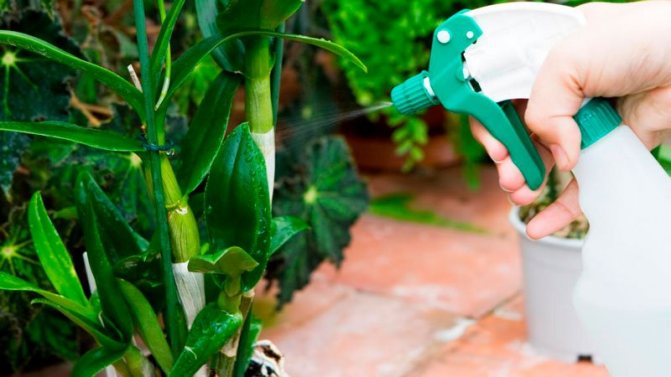

For spraying, as well as for watering, you need to use clean, soft (settled, boiled or melted) warm water. Its temperature should be a couple of degrees higher than the air temperature. Sprayed from a spray bottle with the smallest nozzle, directing water not to the plant itself, but forming a cloud of small droplets above and around it. You can simply put a wide container of water next to the flowerpot for evaporation.
What to do to make a drying orchid bloom? Resume regular watering, bathe it, do not forget about the required level of air humidity.
Useful videos
Video with an easy way to stimulate re-flowering: This video will show you what to do with an orchid after flowering: This video will show you how to convince an orchid to bloom luxuriantly and profusely: The following video will reveal the main reasons why an orchid does not bloom:
Blooming Phalaenopsis orchid is no longer a luxury! This is a popular room decoration, a beloved pet, a symbol of home comfort. However, often the purchased plant is in no hurry to please the owner with repeated flowering. We will tell you why phalaenopsis does not bloom, how to create the best orchid conditions and what to do to make the orchid bloom in your home.
Comments (62)
You do not need to cut the stick! If it has not turned yellow completely, and if it is green, then there is a chance that flowers will appear again from the buds or even children.
The main flowering secret is the temperature difference (day-night)
A + - HOW MUCH ?? WHAT DIFFERENCE SHOULD BE ??
There is a special fertilizer for orchids.
And I have been standing for 3-4 months and not blooming (
There are no pictures, but they just bloom, and it seems to me that the peduncle cannot be removed until it has dried up.
And I read that an orchid can be propagated from a peduncle. So you can baptize not yet dried)
You misunderstood a little. Read the article again.To force the orchid to multiply, you need to lubricate the peduncle with special paste (geoluronic). Isn't it better to buy a ready-made flower without problems.
You can achieve re-flowering from it if you know all the factors contributing to this and follow a certain care regimen
Bloom
Timing
With normal care and compliance with all the necessary rules Phalaenopsis bloom for a long time.
Depending on the variety, they delight with variegated flowers. from two to six months.
At the same time, it is important to take into account care during flowering, it will play an important role in the duration of this process.
Reasons for absence
After flowering, Phalaenopsis, like other indoor flowers, there comes a period of rest. During this time, the stem restores the expended forces, recruits new ones.
Followed by period of active growthwhen a flower can drive out a couple of young leaves and a new peduncle.
If the orchid does not bloom for a long time at home, it is worth considering the reasons for this phenomenon.
Period, for which the peduncle should appear, each variety has its own, in some phalaenopsis, it is shown along with the leaf, and some drive it out after the full development of the leaf blade.
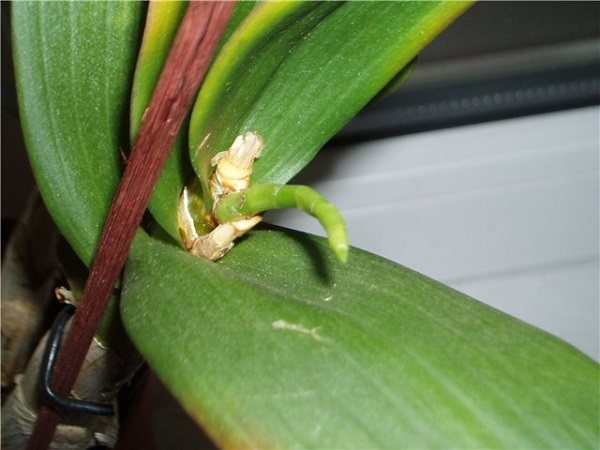

Young peduncle of Phalaenopsis.
Usually the reason that the exotic beauty does not bloom are:
- carried over stressful conditionin which even damage to the plant is possible. Stress for an orchid means a sudden change in the environment, usually when moving or when transporting the stem from the store home in the cold season. In this case, it is possible to get frostbite or simply hypothermia of the plant;
- illness will get in the way of flowering if roots or leaves are affected. The plant simply does not receive the necessary nutrients and will not be able to drive out a high-quality peduncle. Shtambu simply won't have enough strength;
- poor care also will not accompany variegated flowers, only normal watering with a sufficient amount of fertilizers. A place without drafts, light, but without direct sunlight, will contribute to the displacement of the peduncle by the stem and the further development of flowers on it.
In addition, in the absence of flowering, it can be guilty and wrong neighborhood of plantswhich should be strictly observed.
Advice! You should not grow banana trees and tomatoes on the same windowsill or near phalaenopsis. In the summer, protect the bole from the close proximity of apple and walnut trees.
Start
According to research, phalaenopsis, depending on the cultivar and species, fully ready to bloom at 1.5-3 years.
But this is conditional, because everything depends largely on the care and microclimate in the room where the plant grows and develops.
Do not speed up the flowering process. If the plant is too young or weakened after an illness or previous flowering, then stimulation of the stalk pasture can destroy it.
The orchid will gradually start to wither and shed its leaves.
The use of all kinds of artificial stimulants in the form of top dressing will not bring anything good, the plant will quickly deplete and it will be very difficult to save it.
Regular watering
Nurturing care involves lowering hydration for the rest period and gradually increasing hydration upon recovery. With the resumption of watering after a dormant period, new buds begin to wake up, flower stalks grow. But watering should be reasonable, not excessive. With an increase in the amount of light, an increase in air temperature, the need for moisture also increases. They usually water it 2-3 times a week, but the exact watering regime can only be set by an attentive owner individually for each plant.
By the way, the stimulation of the flowering of indoor orchids is done only for adult plants that have already grown from 5 to 8 leaves, this is approximately 1.5–3 years old for different varieties.Excessive watering not only does not stimulate flowering - orchids do not bloom at home during the rainy period, but can cause rotting of the roots, depriving them of the necessary air flow, and compacting the substrate.
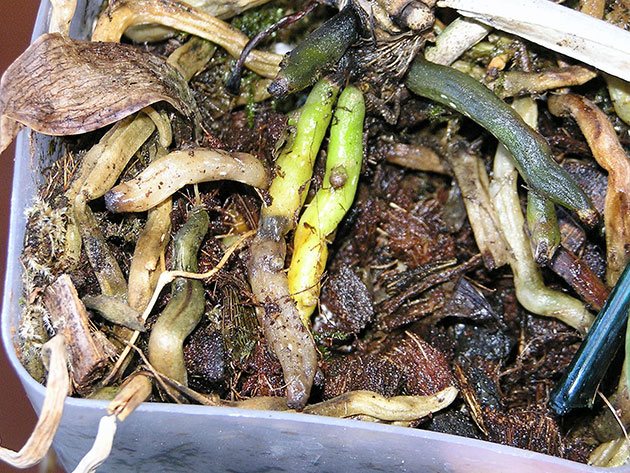

Analysis of the conditions for keeping an orchid
When buying a flower, you need to ask a specialist for an explanation of which variety and features of its cultivation. Phalaenopsis Orchid, the most unpretentious variety that perfectly tolerates light shading. But there are orchids for which the southern window is suitable, and even the summer heat is well tolerated by them. The orchid does not bloom if the conditions of detention are violated.
You should always put a saucer of boiled water next to the orchid. Put a clove of garlic in the substrate.
If the flower was purchased in a store, and it has already bloomed, and the arrow has turned yellow, then the rest period can last up to a year. If the plant is grown from children, then it will take more than two years to wait for the first flowering. By this time, the root system will gain strength and the orchid will release 5-6 leaves. Early flowering will weaken the beauty.
Why doesn't the orchid bloom at home after transplanting? When to wait for the first arrow? The transplanted plant first builds up its root mass within six months. After aerial roots develop, leaves grow. Flower buds are laid in the axils. The initial period of development of the plant in favorable conditions contributes to the establishment of a larger number of peduncles.
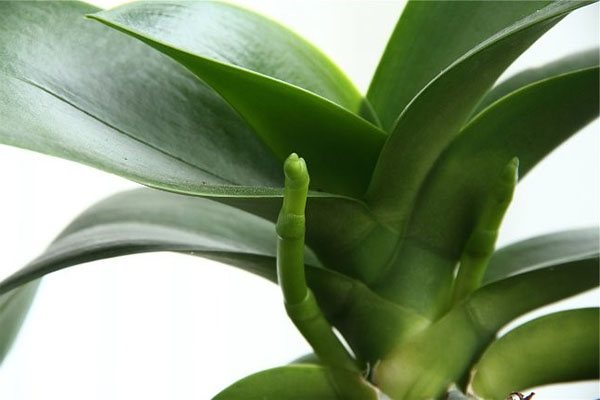

Let us remind you how to properly maintain an orchid:
- The roots are well developed, green, some of them are located along the walls of a transparent pot, some at the top, absorbing moisture from the air.
- The substrate does not contain fresh bark, sawdust or manure.
- It is better to keep the lighting diffused.
- The difference in day and night temperatures when laying the peduncles should be at least 5 degrees.
- Top dressing with liquid fertilizers, depleted in nitrogen every 10 days before the release of the arrow.
The conditions for setting flower buds are listed, but the biological requirements for the maintenance of orchids should be observed.
What if the orchid does not bloom and is developing well? You will need to provoke the release of the arrow. The aerial root and arrow look the same at first. But the tip of the arrow is rounded, and at the root it is sharp, as in the photo.
How to "get the buds to give by changing the watering?"
The watering regime is especially important for the successful flowering of an orchid.... How to speed up flowering by changing watering? Water the plant by completely immersing the pot in water. In order for the dry substrate to be qualitatively saturated with moisture, it is necessary to remove the flowerpot from the decorative pots and lower it into water for 3-5 minutes. After watering, the plant should be pulled out, let the excess water drain from the pot and put it in its original place.
Such manipulations need to be done every two weeks in winter and every 10 days in summer. More frequent bathing can lead to decay of the root system and disease, and sometimes the complete death of the plant.
Orchids gravitate towards the humid climate of the subtropics, so it is important to maintain high indoor humidity.where they are grown. The plant should be sprayed daily using well-settled warm and soft water.
Why don't phalaenopsis bloom?
External factors
In order for the phalaenopsis to bloom, it is worth considering many different nuances, among which the non-last role is assigned external factors, among which in the first place stressful situations. These include:
- hypothermia;
- frostbite;
- a sharp change in the environment.
Besides, drafts will become stress, which are categorically contraindicated for orchids of any kind.
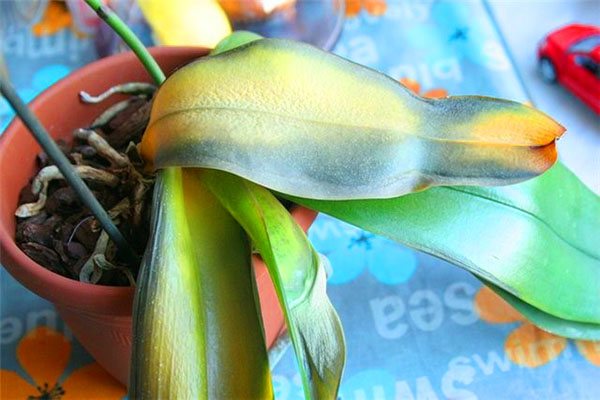

Frostbite of Phalaenopsis leaves.
External factors also include:
- insufficient lighting, this problem is especially acute in the autumn-winter period, when daylight hours are significantly reduced;
- temperature difference affects the flower when the gap between day and night is more than ten degrees.It is such jumps that can put the orchid into a state of stupor, the exit from which can be very protracted;
- incorrect watering regime, when the plant is either flooded or the soil is too dry;
- will play an important role air humidity in the room where the orchid is located. When very dry, it will never bloom;
- from fertilizers you should also be careful, their excess will not help the stem to bloom, rather, on the contrary, it will delay this process for a long time.
Important! It is worth paying close attention to all these nuances, only high-quality and timely care will help your pet to drive out the peduncle and bloom.
Incorrect fit
Influence on flowering can and wrong fit, these words mean immediately a few errors:
- poor quality substrate;
- too much deepening of the plant;
- lack of drainage holes;
- lack of drainage.
All these factors will negatively affect not only the flowering process, but also the growth of the stem itself.
Advice! Pay special attention to the structure of the bark in the substrate, there should be large-fraction pieces and smaller ones.
Diseases
Most often, the flowering of phalaenopsis is inhibited by diseases that prevent the stem from growing and developing normally.
The most common diseases are:
- bacterial and fungal infections, which usually arise due to poor-quality substrate or insufficient processing of the sections after resuscitation or pruning of the plant. They are treated for a long time, it is best to use special preparations - fungicides;
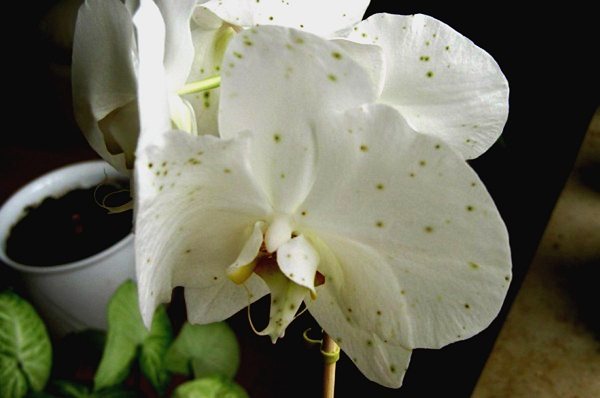

The defeat of the orchid with a fungal infection.
- rotting roots will not contribute to the normal life of the flower, the stem will not have a sufficient amount of all the necessary nutrients. Both the leaves and the trunk will suffer. You should not expect flowering from such a plant;
- salinity of the substrate occurs when overfeeding it with nitrogen fertilizers. In this case, the green part of the plant can actively develop, or the existing one can wilt. Loss of turgor of the deciduous part will be characteristic. There are several ways to deal with these reasons, the most effective will be to change the existing substrate. And you can wait until the excess feeding will gradually disappear with watering;
- after recent transplant experienced flower growers do not expect flowering from phalaenopsis, they know that the stem needs to be "ill", to adapt to the new conditions of the root system.
Sometimes diseases not only interfere with flowering, but can also cause the death of phalaenopsis.
With a formed peduncle
There are times when the plant looks healthy and receives the necessary care. Wherein the orchid does not bloom, but the leaves grow.
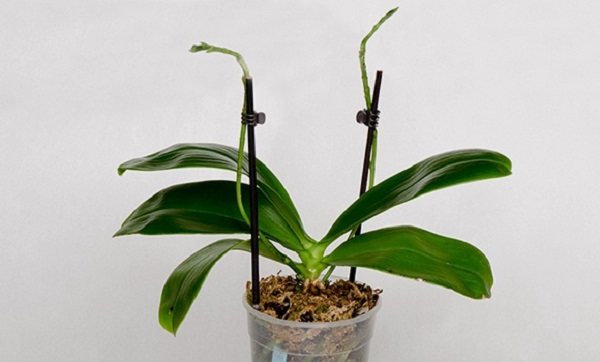

The peduncle is formed, but there is no flowering.
During this period, the forcing of the peduncle usually occurs, but it refuses to bloom. Many people look at this stick with surprise and every day they wait more and more for the buds, but they are not there. The reasons for this phenomenon lie:
- In leaving, most likely, the bole was flooded;
- In an increased portion of fertilizer, which should not be done during the flowering period;
- In a sharp change in the microclimate, when a flower from a store enters our homes;
- Perhaps there was a temperature difference at which the plant went into "hibernation";
- Not enough light.
When the orchid returns all the necessary conditions, it will soon begin to actively throw out the buds, and then it will bloom.
Questions From Readers About Blooming:
How to increase the duration?
Until the buds fully open keep the plant in a well-consecrated place, not less than 12 hours. Then rearrange the flower to another place with a lower temperature. Do not fertilize them during flowering.
When is stress good?
Not all stress is detrimental to flowers. Some of them stimulate flowering... For example, the difference between night and day temperatures by 4-5 degrees C, overdrying of the substrate. It is necessary to expose such stresses during the period when the plant has up to 8 leaves, i.e.e ready to bloom.
How does a sharp temperature drop affect?
There is a concept useful and tolerable temperature... When night readings vary within 15-18 degrees C, and daytime ones - 20-24, the transferred values are 15 and 24 degrees C, respectively.
The intermediate temperature is useful. Any deviation of the transferred values in one direction or another leads the plant to stress.
Why does the death of old roots provoke a process?
When old roots die off reduced suction capacity plants. It turns out a lack of moisture, which provokes the laying of flower buds. From where the peduncle is pulled out, then the buds.
How does reduced watering affect bud blooming?
Buds hungry for disclosure ready for pollination... Just when there is no rain. Orchids also react to lack of moisture. Therefore, they are revealed.
Why do orchid leaves wither?
Overheating and direct sunlight, even if shaded, have a negative effect not only the leaves, but the flower as a whole. It should be transferred to partial shade.
How to create conditions for an orchid to bloom
It must be remembered that phalaenopsis is an epiphyte from tropical rain forests that grows on the bark of trees. Branched aerial roots serve it to attach to a support, trap atmospheric moisture and photosynthesis. We will try to create conditions close to natural for the orchid.
Substrate and pot
The best soil for a plant is the bark. Such a substrate will provide an optimal air exchange of the roots.
The stores sell pine bark-based orchid primers. You can also harvest bark from fallen trees. Pieces of 1-3 cm in size are suitable for planting phalaenopsis. The bark should not contain resin and coniferous sawdust, it must be washed and scalded with boiling water.
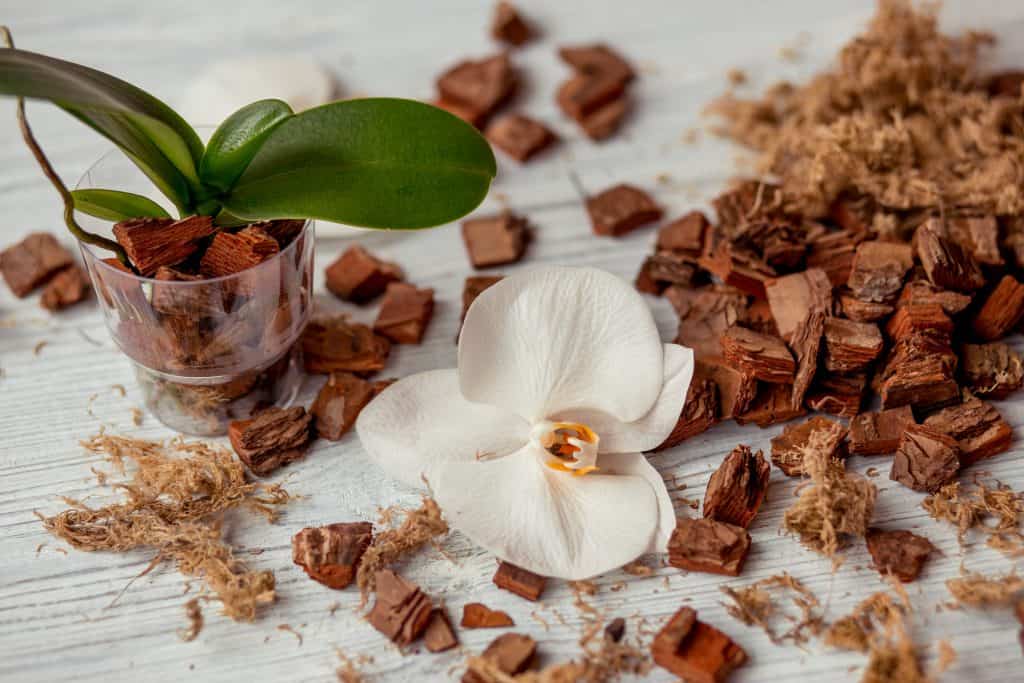

Important: Never add peat mixtures, humus and ordinary earth to the pot! In dense soil, orchid roots rot from waterlogging.
Phalaenopsis orchid pots should be transparent, as its roots are involved in the process of photosynthesis. The optimal material is transparent plastic. Drainage holes in the pot are required! Additional holes can be cut in the lower part of the pot to aerate the roots and soil.
Watering
Phalaenopsis orchid is watered in different ways. Which one to prefer depends on the conditions of the flower and your convenience.
Strait
When spilled from above, the water washes the roots of the plant, flowing down through the drainage holes. You do not need to drain the water from the pan if there is not too much of it, and the air in the room is warm and dry: the evaporating water will humidify the air and gradually be sucked in by the soil.
Top watering advantages:
- waterlogging of the soil rarely occurs;
- can be combined with a warm hygienic shower.
- it is difficult to evenly wet the soil and roots;
- you have to water more often.
Many orchid lovers alternate spilling with dipping the pot in water - soaking.


Soak
Soaking involves immersing the pot in a container of water until the substrate is completely wet. This method has many advantages:
- saturation of soil and roots with moisture;
- it is convenient to make top dressing;
- soaking is required less often than surface watering;
- humidifies the air around the plant.
Disadvantages of the soaking method:
- the bark pops up when the pot is immersed;
- excess water must be drained from the pallet to avoid waterlogging.
Watering the orchid in this way, you need to observe the intervals between watering, drying the soil for 7-10 days.
Lighting
For an orchid to bloom at home, it needs a bright spot. In winter, phalaenopsis does not bloom most often precisely because of a lack of light. With the appearance of the spring sun, the orchid generates flower stalks with buds.
In the dark, as well as on the northern windowsills, it is useful to organize the illumination of orchids with fluorescent lamps or phytolamps with a specially selected radiation spectrum.
At the same time, the hot sun's rays damage the tissues of the stems and leaves. To place a flower, you need to choose such a location so that the plant has enough light, but there is no excess sun.
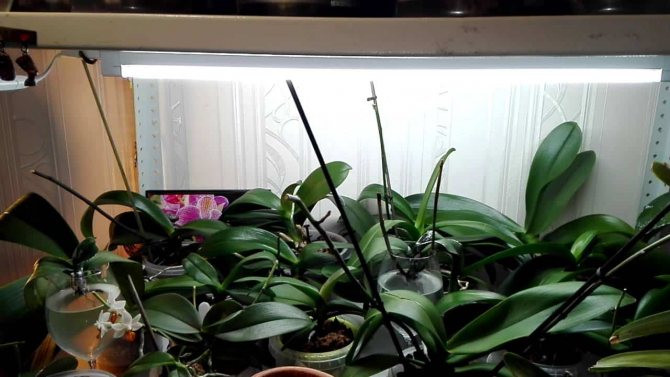

South windows in spring and summer are shaded with tulle or blinds. East and west windows are considered to be the most suitable for orchid placement.
Temperature
Phalaenopsis feels comfortable at room temperatures of 20-25 ° C, although for a short time it can withstand cool up to 15 degrees and heat up to 30.
In winter, the pot with the plant should be protected from the cold windowsill and drafts. Place a wooden or cork stand or other heat insulating material under it.
Summer heat also inhibits orchid development. If possible, shade the plant from direct sun.
Important: for flowering phalaenopsis, a difference between day and night temperatures is needed, as in nature - about 5 ° C.
Stimulation of the growth of peduncles
A plant with 5-8 leaves is ready to bloom. But how to increase the growth of an orchid? In order for the peduncles to grow more actively, they use growth stimulants, i.e. fertilizer:
- In order for the orchid to accumulate strength for the period of lush flowering, it is necessary to start feeding from the moment of active vegetation of leaves, peduncles, buds;
- As soon as the first bud opens, fertilization is taboo;
- The plant needs nitrogen (N), potassium (K), phosphorus (P) and other trace elements;
- Nitrogen is in the lead for growing green mass;
- When a peduncle appears, potassium and phosphorus are added to the bait more. Potassium stimulates the formation of kidneys, increases the immunity of the plant, actively participates in the metabolism. Phosphorus stimulates growth, the flowering process, forms the root system;
- Supplements in the form of magnesium and boron allow the main components (N, P, K) to be absorbed;
- The acidity should correspond to pH 5.5-6.5. You can check it with indicator plates. Deviation from the normal level leads to the fact that the main components will not be absorbed. This is in the case of high acidity. With an increase in the alkaline environment, boron, iron, and copper are not assimilated.
Rules for feeding with drugs
During active growth, liquid NPK fertilizer must be applied in a ratio of 8: 3: 5.
When a peduncle appears, the dosage of NPK changes 2: 6: 6.
Top dressing is carried out every 2 weeks, if the activity falls in the summer. In winter power gap is 30 days.
Fertilizers should be alternated on root and superficial. Frequency will prevent the roots from getting burned. During spraying, the dosage from the instructions should be halved, for complex fertilizers - by 3-4 times.
Freshly transplanted plants are not fed, as in the composition of the substrate there are nutrients.
Recommended drugs
How to feed orchids? Florists recommend using liquid fertilizers... The most popular ones are:
- "Greenworld" (Germany) - before use, shake and dilute according to the instructions for the root system 10 ml per 3 liters of water, in case of spraying, reduce the dosage by 2 times. The solution is brown, odorless. During spraying, remove excess moisture from growth points;
- Bona Forte (Russia) - complex fertilizer. Stimulates re-flowering;
- "Kemira-luxe"... Judging by the reviews of florists, it takes the leading place. There are no complaints about him;
- Substral, Etisso and BioEkor also have a lot of fans;
- "Flora"... It contains natural ingredients. Fertilizer is used for foliar feeding. The container is equipped with a spray.
How to make the phalaenopsis orchid bloom
What to do if the orchid still does not bloom, despite its health, fatness and good keeping conditions? Perhaps your plant is simply "sleeping" or fattening in a comfortable environment, and it needs a "magic kick". I will tell you a few secrets of how to make an orchid bloom.
Physiological stimuli
In order for the orchid to bloom at home, physiological stimulation methods can be applied. To do this, let's experiment with watering and indoor temperature.
It is important to note that the stimulation only works on an adult, healthy plant! There is no need to rape a freshly faded, emaciated or diseased orchid.
Artificial drought
To wake up the orchid, artificial drying is often used: in the tropics, orchids do not bloom during the rainy season. To do this, you need to increase the interval between waterings, which is usual for the plant.
Our task is to dry the orchid without leading to obvious wilting. At the first signs of loss of turgor, you need to shed the plant under a warm shower or soaking method. Then water the plant as usual.


Temperature difference
In nature, orchids experience natural fluctuations in day and night temperatures. In the heating season and in summer, the temperature difference in the house is minimal. Note that orchids often bloom in the spring after turning off the batteries, and in the fall, when the daytime sun is warm, but the heating is not turned on yet.
Let's try to recreate the difference between day and night temperatures. We maintain 23-25 ° C on the windowsill during the day, 18-20 ° C at night - ventilate, close from the heating battery. Such a shake-up should wake up the orchid, which stubbornly does not want to bloom.
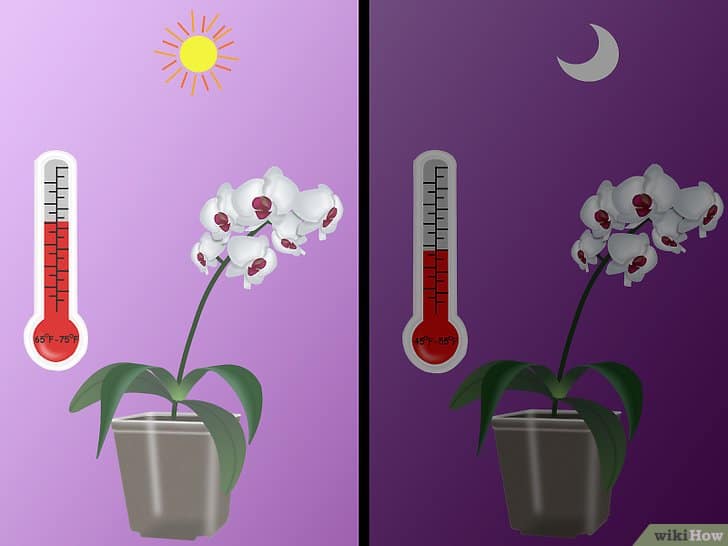

Chemical stimulation of flowering
Can phalaenopsis be made to bloom with fertilizers and stimulants? Of course, there are many tools that actually work.
Fertilizers
The stores sell fertilizer for flowering orchids. Their difference is that they contain less nitrogen, but an increased content of potassium, phosphorus and trace elements. When applying fertilizers, observe the dilution proportions - it is better to underfeed than overfeed.
A popular adaptogen stimulant that helps weakened plants adapt to new conditions and get stronger. A drop of epin is diluted in a liter of water and the plant is sprayed over the leaves.
succinic acid
Safe product that can be bought at a regular pharmacy. It is added to water during watering and spraying. For 0.5 liters of pure water, take a powder on the tip of a knife or one tablet of the product. Succinic acid has a firming effect on the orchid, increases leaf turgor, stimulates the formation of buds.
If it only releases roots and leaves


If the orchid is not blooming but leaves leaves, it may be dormant.... As a rule, the rest time of orchid plants lasts from 1.5 to 3 months, during which the plant should be provided with a cooler temperature regime.
If there is no flowering for more than three months, it is necessary to deal with the irrigation regime, as well as the humidity and temperature in the room where the orchid is kept. It is necessary to correct the conditions of maintenance and create stressful conditions for the plant for the successful distillation of the peduncle.
We recommend watching a video about the reasons for the lack of flowering of an orchid when growing leaves:
Stimulation of the formation of a peduncle in phalaenopsis
The lack of flowering in phalaenopsis can be expressed in different ways. The most common manifestation is the stubborn refusal of the plant to release the peduncle. At the same time, phalaenopsis can feel great, regularly give new leaves, branch out the root system. This is normal for 1-3 months, but sometimes this situation drags on for a year or more.
If the phalaenopsis does not release the arrow for a long time, you can force it to change the phase of the life cycle as follows:
- Artificial drought. At first, watering is gradually reduced to the orchid throughout the month. During this period, bathing in the shower ceases, the immersion of the pot in water, irrigation becomes rare and only through a watering can along the edge of the pot. After a month, watering and spraying completely stop. The dry period can be maintained from 3 weeks to a month.
- Decrease in temperature. This measure enhances the effect of artificial drought.During the drying period, the orchid is placed in cooler conditions than usual, and after the end of the dry period, it returns to its place.
Water requirements
How to water an orchid so that it blooms and with what kind of water? The requirements for the water with which we water the orchid are quite simple and easy to fulfill. The water should be warm, not too hard, and slightly acidic. This can be achieved by performing very simple actions:
- Water should be filtered; ordinary filters that are built into the water supply system, or kitchen stationary ones, are suitable.
- You can simply boil hard water, in which case all excess salts will precipitate during boiling.
- Filtered or boiled water must be defended for at least 12 hours, or better - within a day.
- You can dilute ordinary, settled water 1: 1 with distilled water, this will reduce the hardness and acidity of the water.
- Rainwater use.
Flowering time
In natural habitat, this culture begins its flowering from March-April., and closer to autumn, it drops the buds and begins to prepare for a period of rest and recovery. But at home, everything is completely different: a constant climate is maintained there, so the culture can begin to bloom at any time - from January to December.
Important! You should be alerted to the fact that flowers have not appeared on the plant for more than a year. In this case, it's time to take action.
Orchid subrust so that it blooms
There are the following stimulants for the orchid to bloom. The Epin growth stimulator is very popular among flower growers. This drug is sprayed on the orchid every morning, adhering to a certain time.
Another solution that stimulates growth and antistress for orchids is succinic acid. 2 g of this acid is dissolved in 1-2 l of water. The solution is sprayed completely on the orchid. The solution with succinic acid must be consumed within 3 days.
It is strictly forbidden to treat the orchid with growth stimulants after transplantation; the flower needs some time to take root well. Remember to fertilize in moderation, according to the instructions.
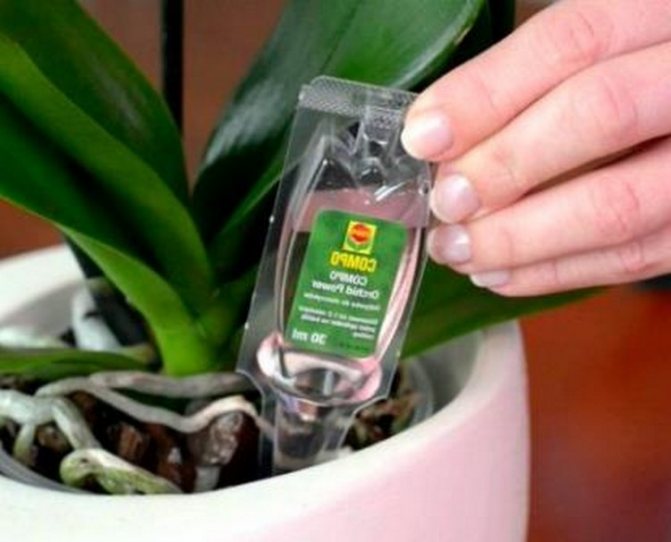

Answers on questions
Question number 1. There are fertilizers on sale marked "specially for orchids", produced in various forms: powder mixtures, sticks, aerosols. Which ones are more effective?
Orchids should be fed only with liquid fertilizers - by immersion, watering or irrigation. Dissolve dry powders in water and filter thoroughly. The solution should not contain any solid particles. All kinds of granules, crystals, sticks that need to be buried in the substrate for gradual dissolution are not suitable for orchids. In the soil used for growing orchids, dry fertilizers cannot be distributed evenly. An increased concentration of the active ingredient can lead to root burns.
The best way to feed an orchid is submerged watering, when the plant is placed in a container of water for 15-20 minutes. When the roots are saturated with moisture, the orchid is immersed in another container with a nutrient solution. Then they are taken out, allowed to drain all moisture and returned to a permanent place.
Question number 2. Is it possible to feed orchids with organic fertilizers such as wood ash, bird droppings, horse manure, water after washing meat?
In addition to useful nutrients, animal waste products contain various microorganisms, including pathogens, which is not at all useful for delicate orchids. In addition, it is worth considering the specific smell emanating from such fertilizers. As for the ash, then the concentration should be strictly observed so as not to damage the roots of the orchid. The solution should be as weak as possible.
Make a decoction of onion peels
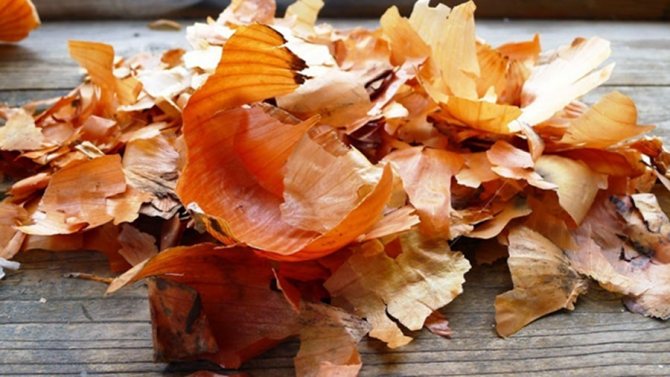

The onion husk contains a huge amount of a wide variety of mineral and biologically active substances that are vital for orchids.For example, phytoncides, mineral salts, carotene, as well as vitamins of groups C, B, E and PP. In addition to the disinfecting effect, this combination of nutrients contributes to the nutrition of plant roots and their tone. Onion hulls are rich in quercetin, which has an extremely beneficial effect on orchids. Especially a lot of this element is found in the bulbs of red varieties. The husk is able to strengthen the plant's immunity, enhance growth and repel pests. It can be added to the soil or prepared for spraying.
Place a handful of husks in an enamel bowl and cover with boiling water (about 1.5 liters). Boil for another 5-7 minutes, let it brew (2 hours will be enough), and then strain. The remaining husk after straining can be used as compost if desired.
Experienced flower growers are convinced that it is enough to prepare such a fertilizer once a month and spray it on the plants and the soil surface for preventive disinfection. But keep in mind that each time this useful product will have to be prepared anew, since the infusion cannot be stored.
Care features
Care for orchids must be very careful. Care mistakes can affect your health and appearance. In addition, a plant that does not like the microclimate does not bloom. Phalaenopsis will feel comfortable if the following conditions are created for him:
- Arrange good lighting for 12 hours a day. Indoor flower pots should be on the south side. If this is not possible, they need to provide an additional light source. The phytolamp is placed at a distance of at least 30 cm from the young shoot.
- Maintain the required level of humidity. The substrate in which the flower grows should not be allowed to dry out. The soil must be kept slightly moist at all times. However, overdoing it with watering is also not worth it - this is fraught with the appearance of rot. In winter, you should additionally humidify the air. But it is not recommended to spray an orchid with a peduncle.
- Do regular feeding. Fertilizers need to be applied twice a month using potassium-phosphorus formulations. It is best to use special mineral preparations for phalaenopsis. Fertilize the plant from the moment the flower arrow appears until the beginning of flowering.
Major mistakes
Novice growers often abuse the ability to artificially stimulate the flowering process. As a result, the plant, exhausted by continuous flowering, dies. If, despite fertilization, the orchid stubbornly does not bloom, then errors in care are affected. In addition to nutrition, many other factors affect the flowering process:
- insufficient lighting;
- violation of the frequency of watering;
- non-compliance with the temperature regime;
- the presence of diseases and pests.
In addition, orchids react painfully to any stress, for example, the use of any aerosol household chemicals, such as air freshener, deodorant, perfume.
Description of appearance and meaning
The peduncle is a thick, dark green twig with a smooth surface and a pointed tip. Along its entire length, equidistant from each other, there are several scales, from which flowers subsequently appear. In young plants, these branches are erect, but over time they can branch out, acquiring different forms.
The orchid releases a flower arrow several times during its entire life span. In some cases, it persists for several years, giving new shoots and flowers. But sometimes it is limited to only one flowering, and then dries up. In addition to flowers, babies can also form on the peduncles.


The peduncle is a thick, dark green twig with a smooth surface
Difference from root baby
It is difficult even for experienced flower growers to distinguish short flower arrows from root children at the stage of formation.The similar shape, color and presence of scales are usually misleading. Also common are places of growth - leaf sinuses. You can recognize a baby by the following signs:
- there is no growth point;
- during development, the tip of the shoot becomes like an open beak;
- the scales are larger, eventually turn into leaves;
- are formed only in phalaenopsis over 6 years of age.
Difference from root
If the orchid has released air roots, even a beginner can distinguish them from a peduncle. The root grows and looks different from the flower arrow:
- grows from the stem at the base of the plant, from where the leaf plates grow;
- unlike the peduncle, the root tip is directed downward;
- the color is green, with a bluish tint, turning up to light green;
- lack of scales;
- the tip of the shoot is rounded.


The difference between the peduncle and the root process
Home-made mayonnaise "Taste of childhood". Cooking recipe with photo
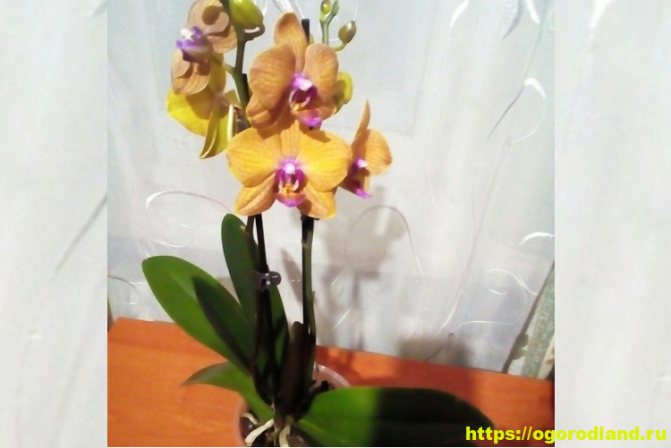

Stimulation of orchid flowering. How to make a beauty bloom Everyone who gets orchid, always brings it to the house already blooming and beautiful. But it often happens that at the end floweringyou can't wait long enough for your orchid threw away peduncle and again pleased you with the beauty of your flowering.
But you really want to admire the truly royal blooming orchid... So how stimulate the orchidso that force her to bloom? We will study this very issue today.
Blooming orchid is the standard of beauty. Only a healthy and well-groomed plant is capable of forming flower stalks and tying buds.
Reasons for the lack of flowering
The absence of flowering is always a consequence that has its own explainable cause. An orchid is a plant that blooms at least 2 times a year, and if you have not seen flowers for more than a year, then you should figure out the causes of this phenomenon and eliminate them.
Resting regime violation. One of the most common reasons why an orchid does not bloom is the wrong dormancy. Many simply do not know how to provide the correct rest for an orchid. We will talk about how to organize it later.
Violation of the watering regime. Improper watering also negatively affects orchids. It is better to underfill them than to fill them. Orchids that are watered abundantly very often may not produce a grower. They do not tolerate waterlogging. In places of their growth in nature during the rainy season, orchids never bloom because there is too much moisture.
Violation of the lighting regime. Lighting plays a very important role in the flowering of an orchid. Its lack or overabundance will lead to the fact that your fussy refuses to please you. She will help you control the light herself, if you give her the necessary attention. It is enough to look closely at the color of the leaves to determine. If the color is normal, then the leaves are green without pallor and darkness. If there is little light, they turn dark green, but if the foliage is too much, the foliage becomes yellow.
Unhealthy roots. Roots are the basis of the plant and of course problems with the root system can lead to the fact that there will be no flowering. When he has been gone for a year, then it is worth examining the root system of your flower. With frequent watering, the roots very often begin to rot, even a small sign of rot will lead to the fact that the orchid will not bloom.
Dormant period
The dormant period for an orchid is very important for the subsequent flowering, if it is not ensured, then you may not see flowering again.
When does the rest period begin? This question is of interest to all novice florists. As soon as the orchid has faded and its peduncle is completely dry, the orchid enters a dormant period. This is a kind of vacation for an orchid in which it just needs to be sent.
In order for the orchid to rest, it must be transported to a lower temperature. Choose the coolest room in your home, the ideal temperature for relaxation is no more than + 18 ° C.
The light should be the same as for a blooming orchid, it should be enough.
Watering during the dormant period is reduced to a minimum; it must be carried out only when the substrate is already completely dry. Watering twice a month will be quite enough, and if the temperature is higher than ideal, then once every three weeks will be quite enough.
Seven Ways to Stimulate Orchid Blossom
When the orchid itself does not want to bloom, the owners have to help it and organize the stimulation of flowering. There are several proven ways to stimulate an orchid to bloom, and we will of course cover them all.
Stress is a flowering stimulant
Stressing an orchid is a long-standing way to make it bloom. To do this, you need to send the orchid to a completely unusual place for it. A place under the bathroom is perfect. The ideal stress for an orchid is coolness, increased moisture and lack of light. It must be sent to the link for 2 weeks. Then place the orchid in its usual place.
Transparent orchid pot
The pot is very important for the flowering of the orchid, now there are a lot of them in stores. But it was and always will be the perfect pot for an orchid - a transparent pot, the same ordinary and nondescript, but very useful and ideal for an orchid. Because its roots really need light, the pot should always be transparent, even if you put it in a planter, then it should also be transparent.
Additional illumination of the orchid
When the dormant period for an orchid falls in the winter, it just needs to be given additional lighting. An ordinary ice lamp is perfect, they need to turn it on for 4-6 hours, depending on the length of daylight hours. If the sun sets already at 4 o'clock, then the light must be turned on for 6 o'clock. If there is not enough light, then flowering can begin not earlier than May.
Overnight stimulates orchid bloom
If your sucking orchid refuses to bloom, then you need to arrange 2 weeks of tropical nights for it. Where it grows in the wild, nighttime temperatures average + 5 ° C. Therefore, the orchid will need to be sent to this temperature overnight. A corridor or basement is suitable as a night tropics, and if necessary, you can put it in a refrigerator if you can create a given temperature in it.
Succinic acid - flowering stimulant
Succinic acid is a great helper for your orchid. It contributes to the health of your beauty. The use of succinic acid stimulates the orchid to eject a peduncle, the growth of foliage and roots. For this purpose, you need to dissolve 1 tablet in 0.5 liters of water. It is necessary to spray it all with this solution, and also pour this solution. It is impossible to overdose with succinic acid, therefore you can constantly water it, spray and wipe the foliage of your beauty.
Flowering and growth stimulant "Epin"
"Epin" used to relieve stress in the plant. If there was a transplant or a change of place, then it must be applied for a non-blooming orchid. It is sprayed on the foliage of the plant; for watering it is never used exclusively by spraying.
Hot shower stimulates flowering
To stimulate flowering, a hot shower is used once a week. Such a shower stimulates sap flow. You need to carry out the most ordinary watering, and after 30 minutes you need to buy an orchid under a hot shower, not just under a warm one, but under a hot one. The concept of a hot shower includes water with a temperature of + 28 ... + 35 ° С, but not higher than + 35 ° С. Higher temperatures can burn the plant. Bathing is carried out for 40-60 seconds no longer. Such a shower can be done not more than once a week.
Fertilizing an orchid for flowering
Until the orchid blooms, it needs to be fed. During this period, she just needs additional nutrition in order for her to be as strong and active as possible and to grow and get stronger.It is best to use complex fertilizers that contain all the necessary vitamins and mineral fertilizers. If you use them separately, it will be difficult for you to alternate and dose. The plus in the complex is that when diluted, you will get the ideal concentration of all components that is suitable for the plant.
When choosing a fertilizer, you need to find out the opinion of those who have already used and are using it. I and all my friends, who are engaged in orchid cultivation, settled on the "Master" fertilizer from. It is necessary to apply fertilizer only according to the instructions, not more often and not increasing the concentration. Overfeeding an orchid can also lead to the fact that it will not bloom.
Fertilizer "Peters" for flowering orchids
"Peters" Is the most popular fertilizer for orchids. It is sold in powder form and is diluted in water according to the instructions. This fertilizer is aimed at rooting or flowering, there is also a form that combines both of these qualities.
"Peters Professional" - this is exactly the fertilizer that can be used for flowering orchids to enhance and prolong flowering, feed during dormancy and stimulate flowering and the formation of new roots and leaves. Also, this form of fertilizer is used to resuscitate plants that are sick. It is ideal for transplant recovery.
In general, this fertilizer is universal and you will not need to think at what period of your beauty's life to use it so as not to harm. For a beginner grower "Peters Professional" is a real find.
Repeated flowering of an orchid peduncle
When the flowering is over, this does not always mean that the orchid has completely faded and the peduncle needs to be removed. Do not do this under any circumstances. If the peduncle does not turn yellow yet, this means that it is not yet dry and may bloom, but it needs help and stimulation.
An assistant in stimulating the flowering of the peduncle will be "Cytokinin paste"... This paste is nothing more than the hormone cytokinin, which is a potent flowering stimulant. However, remember that this paste can only be used on healthy plants. Diseased plants and weakened plants may not survive such powerful stimulation.
Cytokinin paste
In order to do this, carefully examine the peduncle, or rather the buds. If the scales on the bud are green and without dryness, then you can use these buds to stimulate the appearance of the cuttings of the peduncle, which will give flowering. Look at the scale in the photo:
Fit kidney
Then take a thin needle, the most common one you use for sewing. Dip it in alcohol in order to disinfect the needle and not harm the plant by infecting it.
Disinfection of a needle
Scratch the scale in the center and open it, revealing the kidney as shown in the photo:


Opening an orchid bud with a needle
Then, using a needle, apply the paste to the kidney, spreading it over the kidney. How to do this, see the photo. Then, after applying the paste, close the flake as in the photo:


Paste application
That's all, wait for the growth of the bud and the new flowering of your beauty. Within a week you will receive layering.
Orchid care tips
When you carry out the required spraying, it is necessary to use the nozzle only with a fine spray. After spraying, be sure to check for water at the base of the leaves. If there is glass of water, be sure to remove it from there by blotting it with a cotton pad, then wipe it with a cotton swab to keep the base dry.
When giving your orchid a hot shower, be sure to check the temperature and also remove the water from the base of the leaves, otherwise they will start to rot.
You should not often change the place of the orchid, she is going through this hard.
During the formation of the buds, do not rearrange or move the pot of orchids, she will not like such anxiety, and she may partially reset them.
Never overfeed the orchid with fertilizers, it is better to let there be a shortage than too much, it is dangerous for their health. It is recommended to fertilize with every second watering, it is not worth applying fertilizer every time.
When you are stimulating an orchid to bloom and buying a fertilizer for this, make sure it contains potassium components. It is they who provoke flowering.
Excellent (0) poor (0)
Phalaenopsis with a "frozen" peduncle: what to do?
Another option for inhibition of flowering is less common. It is expressed in the fact that the peduncle that began to form suddenly stops growing. In this case, the problem is solved differently:
- The humidity of the substrate and air is checked. Watering is normalized so that the orchid is well supplied with water, but the substrate does not remain wet for more than a day. Air humidity rises to 60-70%.
- A phytolamp is installed over the orchid. In this case, the main luminous flux is directed to the tip of the peduncle.
- Foliar top dressing with boron fertilizer is performed. To do this, you can dilute boric acid in water (1 g per 1 l) or use a special complex fertilizer for orchids containing boron.
It is also worth checking the air temperature. At this stage, daily differences should be maintained, but too low night temperatures are contraindicated. During the period of peduncle growth, the optimal thermometer at night is +18 0 C.
Top dressing for successful flowering of phalaenopsis
Top dressing plays a secondary, but important role in the regulation of orchid flowering. Sometimes phalaenopsis refuses to bloom if it is depleted, and then the plant must be given one of the following fertilizers:
| Name | Description | Application |
| "Pokon for Orchids" | Complete complex with good phosphorus and potassium content, enriched with boron, manganese, iron, zinc, copper and molybdenum. | In 1 liter of water, 5 ml of the drug is dissolved, watering is performed at the root. |
| "Dr. Foley Orchid" | Ready-to-use solution in the form of a spray containing a complete set of nutrients, enriched with B vitamins and amino acids. | Spray the leaves and aerial roots once a week. |
| "REASIL for orchids" | An innovative formula with a full complement of mineral elements in the form of salts and chelates, enriched with succinic acid, amino acids and B vitamins. | For irrigation - 1 ml of fertilizer is diluted per 1 liter of water. |
For spraying - 1 ml of fertilizer is diluted into 2 liters of water.
For the start of flowering, an orchid needs normal phosphorus supply. Therefore, during the growth of the peduncle, it is necessary to regularly apply phosphorus-containing compositions.
Expert advice on stimulating phalaenopsis flowering
When an orchid refuses to bloom, there is a great temptation to use some kind of hormonal stimulant - for example, cytokinin paste. But it is better to refrain from using such funds:
“There is no need to smear the axillary buds of phalaenopsis with cytokinin. In most cases, the lack of flowering is associated with a lack of light, and hormones in such conditions only exacerbate the situation. Good light, correct temperature and moderate irrigation - and Phalaenopsis itself will bloom regularly and profusely. "
K. Suprun, 22-year-old florist, orchid collector
Does an orchid need a permanent place?
We often cannot answer unequivocally. Many believe that an orchid that blooms should not be moved from one place to another and even turned. Abundant diffused light is said to be an excellent method for prolonging flowering.
In reality, the opposite is true. It is recommended to do as follows: the plant has bloomed on the window - bring it to the center of the room. It should be noted that a blooming orchid, for example, on a fireplace or a piano will be especially attractive and will make the interior of your home a little exotic. Don't be afraid to move your flower to the back of the room.


This phalaenopsis did not bloom all summer, but did not bloom its buds in the fall.I'll thank him anyway!
Phalaenopsis needs support, in the truest sense of the word
When buds appear on the flower stalk, it becomes very heavy. Install the support and attach a curvy arrow to it. The "stick" can be purchased together with the culture or separately.
The support will be useful:
1. The flower plant will not break and will not overturn the container, you just need to correctly determine the fulcrum.
2. The orchid will have a decorative appearance.
Insert it gently into the container without hitting the root system. If suddenly it rests and does not enter, slightly stir and find voids. You may need a wire or clip to secure the arrow.
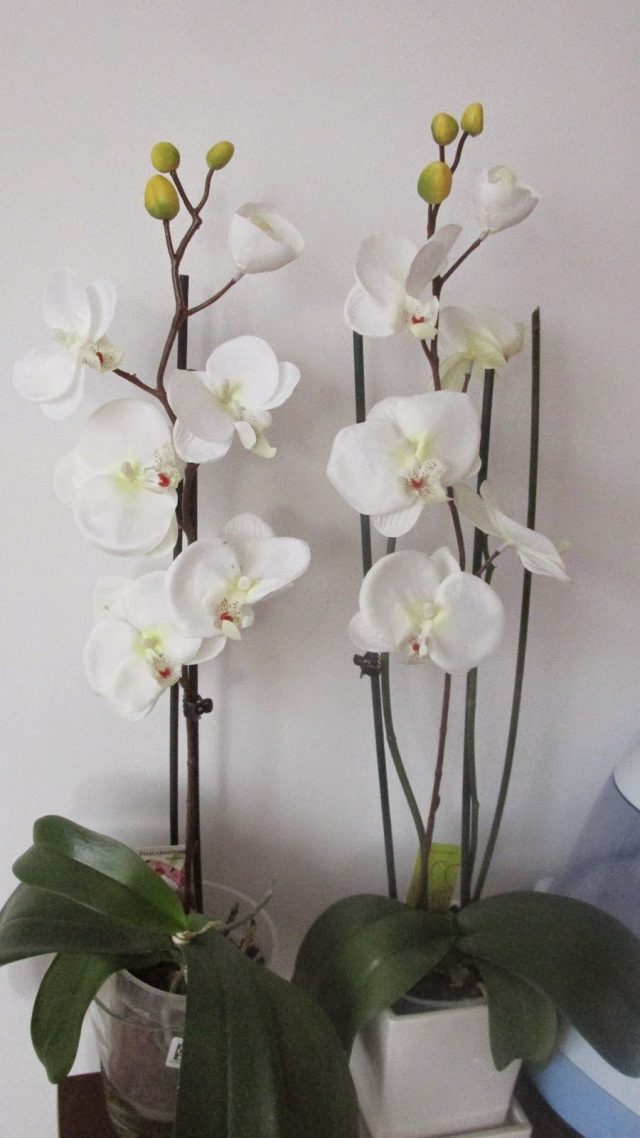

Phalaenopsis cannot cope without such support!
Errors leading to inhibition of phalaenopsis flowering
The long absence of flowering in phalaenopsis orchids is often caused by mistakes made by flower growers:
- Frequent and abundant feeding. Orchids should not be overfed, especially with nitrogen-containing fertilizers. The nutritional requirements of these plants are much lower than that of any others.
- Failure to maintain a balance between humidity, air temperature and illumination. These three conditions must be clearly regulated. At a high temperature, there may be more light and moisture; in a cool apartment, watering and spraying should be rare, but the amount of light should be sufficient.
- Abuse of stimulants. Even healthy vitamin supplements should be used in moderation. Moreover, this applies to hormonal drugs, which, in case of overdose, cause the opposite effect - not stimulation of growth and flowering, but oppression.
Blooming is also inhibited by such circumstances as the frequent change of the location of the orchid in the apartment, transplantation or treatment with potent systemic pesticides.
What to do when the plant fades?
Shedding the last petal, the orchid goes to rest. At this time, she begins to prepare for a new flowering and accumulates strength for this. Meanwhile, care during this period is practically no different - you need to water abundantly, ensure high humidity, sufficient lighting and timely destroy pests. But feeding should be reduced.


It's time to move the orchid to another container. A transplant is done when the roots begin to crawl out of the container or the earth is in a dry state or dries up quickly. Usually, the transplantation procedure is done when the age of the plant approaches or exceeds 2-3 years.
The actual question of stimulating the flowering of phalaenopsis
Question number 1. How to get phalaenopsis to release multiple peduncles?
No way. The plant is a living organism, and independently regulates the number of arrows that it can grow. It is only necessary to provide the orchid with full care and suitable conditions, and there is no need to specifically interfere with the natural development process.
An orchid is a complex and capricious flower that needs to be surrounded by attention and care. Many growers complain that their indoor plants have not bloomed for years. This is due to improper orchid care. If you follow certain rules, then you can achieve very good results.
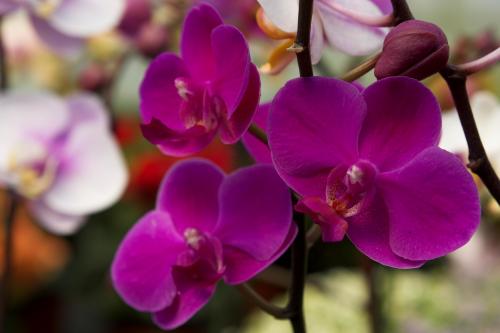

How to perform flowering stimulation
Experienced flower growers most often use the following methods to stimulate orchids to bloom:
- Change in temperature and lighting conditions. Sometimes an orchid does not want to bloom in conditions that are comfortable for it, and in order for the flower to release a peduncle, it is necessary to create a little stress for the plant. You can change the place of "permanent residence" of the flower for several weeks, transferring it to a darker and cooler place. If such a place cannot be found, daily night ventilation sometimes helps (of course, it cannot be carried out if the temperature outside the window is freezing).Such a stressful effect can only be carried out with healthy and strong plants, at least 3 years old and having at least 5-6 leaves.
- Changing the watering conditions. If an orchid is regularly watered, it may not release a flower arrow, since in natural conditions the plant does not bloom during the rainy season. In order to force the plant to bloom in indoor conditions, it is necessary to reduce watering, or increase the intervals between repeated waterings (for a period of about two weeks). If it was possible to force the plant to release a flower arrow, watering must be resumed in the same mode in order to prevent a lack of moisture.
- A gentle way to stimulate flowering is to use a "water bath". To do this, instead of another watering, you need to put a flower pot in the bathroom and water it with a warm shower (temperature not higher than 35 ° C, low water pressure) for about 15-20 minutes. After that, the orchid must be left in a steam-filled bathroom for a while in order for the water to drain.
- Correct fertilization. To feed plants, it is better to use special fertilizers designed specifically for these crops. They are now available in a wide variety and are generally well balanced. Experienced growers advise using urea-free supplements for feeding, in which there is too much nitrogen. To stimulate flowering, it is recommended to use additives that include potassium, magnesium and phosphorus.
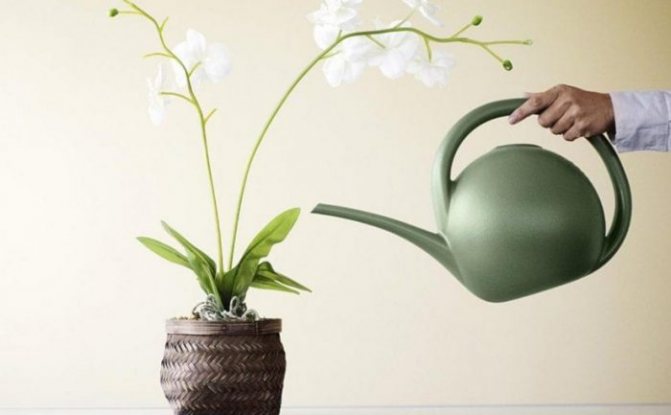

Secrets of experienced florists
To varieties that are capable of bloom all year round, include Phalaenopsis, Wanda, Dendrobium, etc.... They do not have a clearly defined dormant period, therefore, with proper care, they will delight the hostess with flowering all year round.
For this you need to observe the correct temperature regime, watering, lighting and complementary foods... If the peduncle is dry after flowering, it must be cut off. This will help speed up the process of releasing new ones.
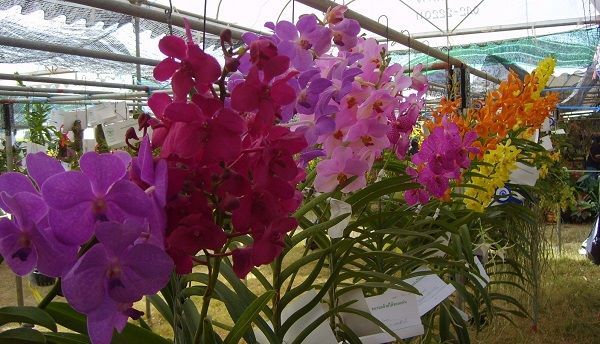

The Wanda Orchid can bloom all year round.
How to improve the condition of the plant?


Here, first of all, you need to pay attention to the nuances of the orchid's well-being. If neither leaves nor flowers grow in her, then the reason may lie only in one thing: you do not follow the rules for caring for the plant described above. One item may be missing, or you may not be following several tips at once. remember, that the orchid is also alive, so chaotic care of it will not work, in this case, everything should be according to the instructions. We didn’t come up with them - it’s not for us to cancel them.
If the plant only produces roots and leaves, then we can say with complete certainty that you have gone too far with nitrogen fertilizers. They stimulated the active development of the green part of the flower, which in turn stopped the growth of flower buds. Fertilizers should be variable (one week - nitrogen, another week - potassium and phosphorus) or complex (here you will definitely not go wrong, so it is better to opt for this option).
Possible reasons for the lack of flowering and how to eliminate them
In order for the orchid to delight with its flowering as often as possible, all possible reasons should be identified why the flower may feel uncomfortable. These reasons include:
- Plant diseases... To exclude them, you should carefully examine the flower. Cases of concern may be: softened or rotten roots, black, yellow or white spots on the leaves, yellowing of the leaves and the appearance of watery patches on them. If foci of the disease are found, they must be immediately removed, and then analyzed, the symptoms of which disease is this defect and the disease must be eliminated with the help of special preparations.
- The presence of pests... Since pests can weaken the plant, it may be too weak to release a flower arrow.The best way to get rid of this problem is to pick up the pests by hand, followed by a complete treatment of the flower with special chemicals.
- Excess food, namely the addition of nitrogen fertilizers in large quantities, as a result of which the plant forms new leaves, but does not release peduncles. You can feed orchids throughout the year, but it is best to add fertilizers in the fall, spring and winter, while the fertilizer should be diluted in strict accordance with the instructions. Orchid fertilizers are usually available in liquid form. They are added directly to the substrate, or to the water used to water the plant. You can also spray the plant with a spray bottle.
- Not enough leaves... Since an orchid must have more than 5 leaves for flowering, their number indicates that the plant is too weak, or very young. In neither case, you can stimulate flowering, since it can greatly weaken the orchid or completely destroy it.
- Wrong care conditions, which was mentioned above.
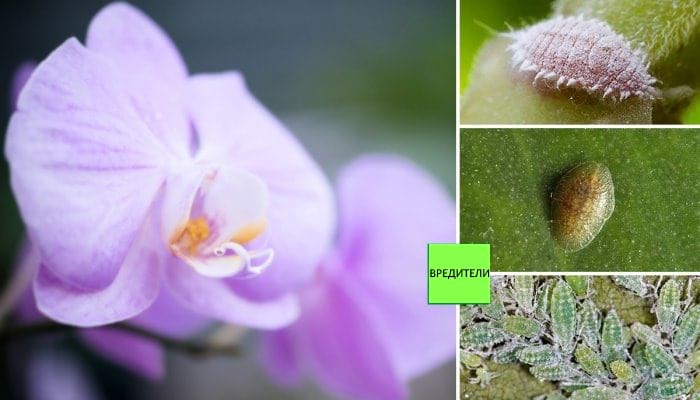

Growing errors
In an adult and seemingly healthy orchid, the lack of flowering can only be explained by improper care.
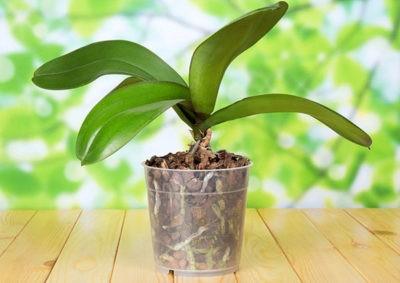

Since caring for phalaenopsis is a complex and complex activity, a mistake can be hidden at any stage.
Major mistakes leading to a lack of flowering:
- wrong temperature regime;
- insufficient lighting;
- direct sunlight;
- excessive watering;
- watering with too cold water;
- bust with fertilizers;
- transplant errors.
Conditions for the normal flowering of phalaenopsis
Despite their adaptability to any conditions of detention, phalaenopsis, like other plants, begin to release flower arrows only under certain conditions:
- Long daylight hours and intense sun exposure. In ordinary Russian apartments, where plants chronically lack sunlight for six months, this condition is not ensured. Normal daylight hours for orchids are 12 hours. Therefore, starting in autumn, the missing hours of natural light must be filled with artificial light.
- Daily drops in air temperature. Phalaenopsis are thermophilic orchids, but they bloom only with fluctuations in day and night temperatures. It should be warm during the day and cool at night, and the temperature difference is desirable in the range of 5-8 degrees.
- Change of "seasons of humidity". In tropical forests, where orchids of this species grow in nature, the change of the season of rains and droughts is very pronounced. Hybrid Phalaenopsis are better adapted to the absence of such a change, but still bloom better after temporary drying.
Among the accompanying conditions for the normal flowering of phalaenopsis, one can name the age of the plant and its state of health. It is understood that an orchid suffering from infections or pests, undergoing pesticide treatments, can take long breaks between blooms.
Important! Phalaenopsis, like other orchids, have a resting phase, only normally it is poorly expressed in them. Therefore, you do not need to expect constant flowering from the plant. There are different phases in the life cycle of phalaenopsis, and a short break in flowering is necessary for them to grow roots and leaves.

